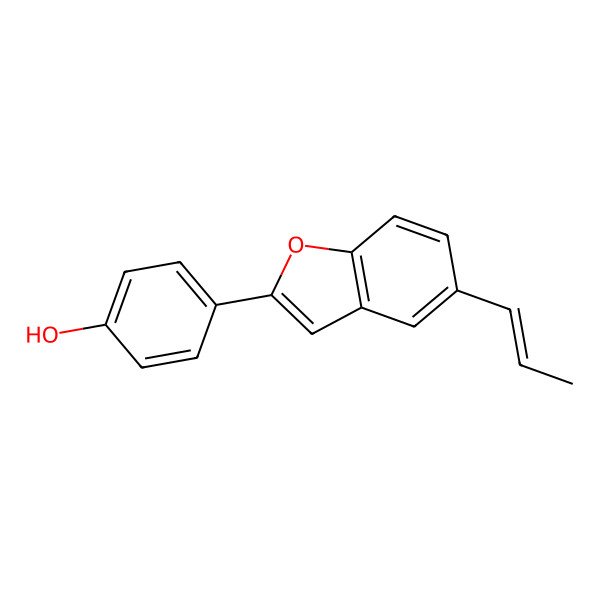2-(4-hydroxyphenyl)-5-(E)-propenylbenzofuran
| Internal ID | 2d1c9d09-747f-4d00-ae05-0f0de7862080 |
| Taxonomy | Phenylpropanoids and polyketides > 2-arylbenzofuran flavonoids |
| IUPAC Name | 4-[5-[(E)-prop-1-enyl]-1-benzofuran-2-yl]phenol |
| SMILES (Canonical) | CC=CC1=CC2=C(C=C1)OC(=C2)C3=CC=C(C=C3)O |
| SMILES (Isomeric) | C/C=C/C1=CC2=C(C=C1)OC(=C2)C3=CC=C(C=C3)O |
| InChI | InChI=1S/C17H14O2/c1-2-3-12-4-9-16-14(10-12)11-17(19-16)13-5-7-15(18)8-6-13/h2-11,18H,1H3/b3-2+ |
| InChI Key | OAMUEWCGJSSPRS-NSCUHMNNSA-N |
| Popularity | 3 references in papers |
| Molecular Formula | C17H14O2 |
| Molecular Weight | 250.29 g/mol |
| Exact Mass | 250.099379685 g/mol |
| Topological Polar Surface Area (TPSA) | 33.40 Ų |
| XlogP | 4.60 |
| CHEBI:69252 |
| 2-(4-hydroxyphenyl)-5-(E)-propenylbenzofuran |
| DTXSID801253246 |
| BDBM50391887 |
| 4-[5-(1-Propenyl)benzofuran-2-yl]phenol |
| 4-[5-[(E)-1-Propenyl]benzofuran-2-yl]phenol |
| 4-[5-(1E)-1-Propen-1-yl-2-benzofuranyl]phenol |
| Q27137591 |
| 4-{5-[(1E)-prop-1-en-1-yl]-1-benzofuran-2-yl}phenol |
| 109194-69-6 |

| Target | Value | Probability (raw) | Probability (%) |
|---|---|---|---|
| No predicted properties yet! | |||
Proven Targets:
| CHEMBL ID | UniProt ID | Name | Min activity | Assay type | Source |
|---|---|---|---|---|---|
| CHEMBL5658 | O14684 | Prostaglandin E synthase |
5300 nM |
IC50 |
PMID: 21800856
|
Predicted Targets (via Super-PRED):
| CHEMBL ID | UniProt ID | Name | Probability | Model accuracy |
|---|---|---|---|---|
| CHEMBL242 | Q92731 | Estrogen receptor beta | 98.20% | 98.35% |
| CHEMBL5619 | P27695 | DNA-(apurinic or apyrimidinic site) lyase | 95.98% | 91.11% |
| CHEMBL1293249 | Q13887 | Kruppel-like factor 5 | 91.94% | 86.33% |
| CHEMBL2288 | Q13526 | Peptidyl-prolyl cis-trans isomerase NIMA-interacting 1 | 91.20% | 91.71% |
| CHEMBL1806 | P11388 | DNA topoisomerase II alpha | 89.78% | 89.00% |
| CHEMBL2581 | P07339 | Cathepsin D | 89.53% | 98.95% |
| CHEMBL2487 | P05067 | Beta amyloid A4 protein | 88.87% | 96.74% |
| CHEMBL3194 | P02766 | Transthyretin | 86.63% | 90.71% |
| CHEMBL4261 | Q16665 | Hypoxia-inducible factor 1 alpha | 86.57% | 85.14% |
| CHEMBL3401 | O75469 | Pregnane X receptor | 86.53% | 94.73% |
| CHEMBL3038469 | P24941 | CDK2/Cyclin A | 84.04% | 91.38% |
| CHEMBL301 | P24941 | Cyclin-dependent kinase 2 | 83.99% | 91.23% |
| CHEMBL3108638 | O15164 | Transcription intermediary factor 1-alpha | 83.53% | 95.56% |
| CHEMBL1075094 | Q16236 | Nuclear factor erythroid 2-related factor 2 | 83.25% | 96.00% |
| CHEMBL3959 | P16083 | Quinone reductase 2 | 83.11% | 89.49% |
| CHEMBL2208 | P49137 | MAP kinase-activated protein kinase 2 | 82.24% | 95.20% |
| CHEMBL5845 | P23415 | Glycine receptor subunit alpha-1 | 81.58% | 90.71% |
| CHEMBL5339 | Q5NUL3 | G-protein coupled receptor 120 | 81.52% | 95.78% |
| CHEMBL2107 | P61073 | C-X-C chemokine receptor type 4 | 81.42% | 93.10% |
| CHEMBL1293255 | P15428 | 15-hydroxyprostaglandin dehydrogenase [NAD+] | 80.57% | 83.57% |
| CHEMBL5409 | Q8TDU6 | G-protein coupled bile acid receptor 1 | 80.25% | 93.65% |
Below are displayed all the plants proven (via scientific papers) to contain this
compound!
To see more specific details click the taxa you are interested in.
To see more specific details click the taxa you are interested in.
| Baliospermum solanifolium |
| Caiophora coronata |
| Hemsleya graciliflora |
| Krameria cytisoides |
| Krameria erecta |
| Krameria lappacea |
| Nepeta erecta |
| Skimmia melanocarpa |
| PubChem | 53483951 |
| NPASS | NPC163029 |
| ChEMBL | CHEMBL2147422 |
| LOTUS | LTS0201759 |
| wikiData | Q27137591 |